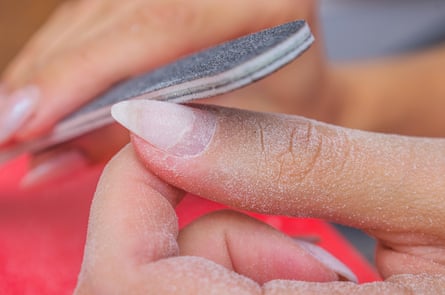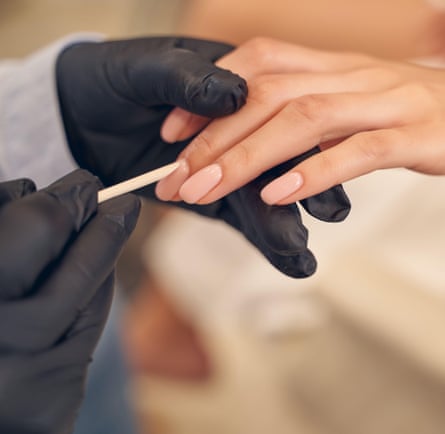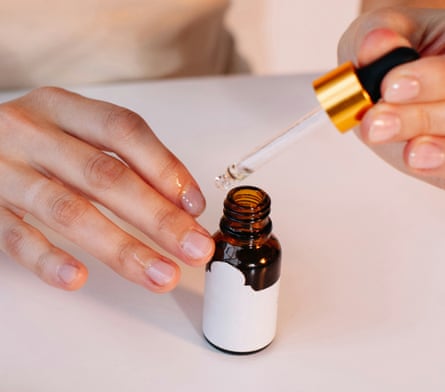If you’ve ever made a regular commitment to gel, acrylic or shellac manicures, you know the removal process (and its aftermath) is not always pretty. Layers of cured polish are often filed or buffed away, manually or with a machine, and then nails are soaked and wrapped in acetone to remove the remaining polish. Finally, they are buffed again in preparation for the next application.
Removal and reapplication is a recurring cost, sometimes as frequent as every fortnight. A recent consumer survey found a rising number of Australians are cutting back on beauty treatments, such as manicures, as cost-of-living pressures mount.
But those going from gel to natural nails in the name of austerity are likely to encounter a painful growing-out period.
“Wearing traditional acrylics, dip powder manicures or gel polish for some time can seriously dry out the nails, making them brittle and susceptible to breaks after removal,” says nail technician Margaret Wandyga of Margaret’s Nails in Sydney.

The removal process
Dr Shreya Andric, a Sydney dermatologist, says the techniques used to remove the polish are one of the most damaging aspects of frequent shellac manicures.
That being said, if you are planning to quit the nail bar and you have powder-dip nails or extensions, it is probably worth booking one last visit to get everything off.
“Soft gels and acrylics can be soaked off with acetone, [but] hard gels will need to be buffed off,” Melbourne nail technician Clara Hwang says. If you have the latter: “I highly recommend either going to a good nail tech just for removals.”

Wandyga suggests looking for a technician who prioritises nail health because it “can’t be rushed”. “Aggressive methods of removal can cause extensive nail damage,” she says. “Gel polishes and other nail enchantments can be safely removed using an e-file in the salon, but please choose a salon where speed isn’t prioritised over quality.”
She says nail technicians need to use many disposable products for this service, “and disinfection and sterilisation aren’t cheap either”. “If the service is too cheap it means that something has been compromised.”
Removing soft gels such as shellac at home will take longer than in the salon, but it is “completely achievable” if you follow the instructions, Wandyga says. She recommends using CND’s shellac removal kit, which will work for other brands of polish too. “It is a simple process but I would recommend wrapping one hand at a time.”
And no matter how tempting it may be, don’t tear off peeling polish as this is likely to take layers of your natural nail off with it.
Restoring natural nails

While many manicurists use clippers to trim cuticles, this is ill-advised, Andric says. “The cuticle protects the new nail from infection as it grows through. Cutting this away makes infection much more likely.”
Instead of cutting the skin, Anna Ross of vegan nail care brand Kester Black recommends DIY manicurists soak their hand in a bowl of warm water then gently pushing cuticles back with a rubber or wooden pusher.
To prevent further damage, Andric suggests keeping nails clean and dry, which means using gloves while doing the dishes or gardening. “A cuticle oil will help to protect your nail and cuticle from trauma,” she adds.
Wandgya says her salon recommends using Dadi Oil by Famous Names ($15.95 for 14.3ml), which she describes as a “fantastic skin conditioner which repairs and moisturises damaged nails, without leaving greasy residue”.
“It can be used on the bare nails, nails polished with regular polish, gel polish or other nail enhancements.”

She also recommends keratin treatment Rescue Rxx by CND ($34.95 for 15ml), which she says “rejuvenates the natural nail plate … reducing splitting, peeling and white spots”. However this only works when applied directly to bare fingernails.
For a cheaper option, Sally Hansen’s vitamin E nail and cuticle oil is well reviewed by customers and costs around $9 for 13.3ml at discount chemists.
Cut and cover the damage
Andric says fingernails are made from keratin, the same protein that makes up our hair and the top layer of our skin. And much like when hair gets split ends, the best way to fix the damage if our fingernail tips are peeling, breaking or splitting is to cut it off.
Hwang suggests keeping brittle nails short and neat. If you cut and file them regularly, they’ll have less of a chance to break.
Wandgya says nail-strengthening products do work but they are topical, so once the product comes off “the damage will still be there”.
Fortunately, despite the urban legends, nails do not need to “breathe”. “Our nails receive oxygen through the matrix from the bloodstream, not the air,” Wandyga says. That means they will grow out and recover perfectly well while coated in polish. “If [natural nails] are feeling weak, pop on a nail-strengthening base coat and some polish to give it some flexibility and strength coverage.”
Ross says home manicures follow some pretty basic steps. First you cut and file, then clean the nails and apply a base coat, two coats of polish and a top coat to seal it all in. Once the polish has dried, finish with a cuticle oil – to apply, gently massage it in towards your hands, using small circular motions.
Finally, be prepared to give your nails months to fully recover, Wandyga says. “Considering that natural nails grow 1.2mm per week, this process can take some time.”
Stay connected with us on social media platform for instant update click here to join our Twitter, & Facebook
We are now on Telegram. Click here to join our channel (@TechiUpdate) and stay updated with the latest Technology headlines.
For all the latest Education News Click Here
